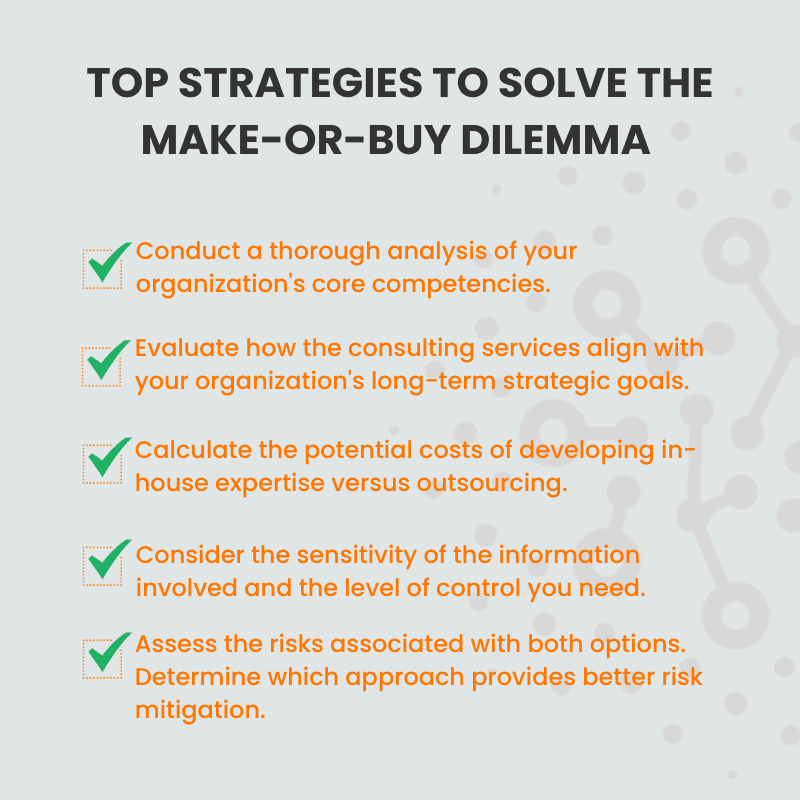The debate between “Make or Buy?” has been a cornerstone in business strategy for years. Yet, surprisingly, when it comes to “make-or-buy for consulting services”, many companies often overlook this crucial decision-making process. With in-house teams readily available, one might wonder, “Why venture outside?”
This is particularly perplexing for firms boasting internal consulting groups. Peter Drucker aptly pointed out, “Making good decisions is a crucial skill at every level.” The choice between internal and external expertise, while appearing simple, is mired in layers of complexity, each with its own merits and drawbacks.
As we delve deeper into this topic, we aim to unravel the intricacies of this decision, shedding light on an area often left in the shadows.
Make-or-Buy for Consulting Services? How to Decide
When you launch a project, you should always check first if you can use Internal resources. Because it often means keeping the costs at a minimum and optimizing the use of your internal skills and resources.
Most companies and their procurement function work to optimize their external spend and their pool of suppliers to better support the overall strategy. They have developed methods for answering a variety of difficult questions:
- What are the key activities that can be outsourced?
- What does the pool of potential suppliers look like?
- How mature is the market for suppliers?
- What providers are appropriate for us?
- Is it worth it to outsource a particular activity for the long term?
The same questions apply to Consulting Procurement. Unfortunately, most companies have neither the experience nor the methods to answer them.
Yet, today, all leaders throughout an organization, from the head of procurement to senior executives responsible for signing off on major consulting projects, are expected to align their activities with the enterprise’s overall strategy.
When it comes to making decisions about consultants, executives often fall back on word of mouth, on perceptions of the reputations of various providers, and the fancy claims of the consultants themselves.
Also, they take the line of least resistance and simply hire the consultants they have used in the past, regardless of whether those consultants are the most appropriate for a particular project or furthering the company’s broader strategy.
These leaders have no reliable way to determine whether a particular consultant precisely meets the company’s needs, no way to gauge a consultant’s likely level of performance, and no benchmarks against which to compare providers.
And until they avail themselves of an independent, credible means of assessing providers and matching them to their company’s needs, they are likely to lag their competitors who have.
Internal, External or Hybrid? How to Solve This Dilemma?
Because they are very familiar with the problem, these Consultants can usually solve it more efficiently and at less cost than Internal resources.
They can also make up for the lack of internal resources and flexibility that prevents internal personnel from being diverted from their regular jobs.
Clients may also want to use consultants for broader purposes than the project itself.
These could include training executives on new skills, introducing external change agents, learning best practices in the industry or a capability, exposing the organization to a fresh perspective, or relying on the stamp of a recognized consulting brand to reassure board members or investors.
But even under those conditions, hiring external consultants is not always the best solution. For example, consulting services that meet your needs may not be available in your industry or country.
On the other hand, leading an internal project can be tricky. The internal team may be unaware of the latest trends in the industry or capability. They may waste time reinventing already well-established improvement methodologies, resulting in longer projects and higher overall costs.
But this option can very quickly reach its limits if the project team is not given the appropriate time and responsibilities to lead the project efficiently.
Moreover, because the leaders of internal projects are often high-potentials on the leadership fast track, they find it challenging to push boundaries and confront the more established leaders and influencers who hold the key to their careers.
Assigning an independent task force can bring focus, speed, and pressure to the table, which is sometimes enough for the success of a project.
And maybe to achieve the best performance, we need to look at the middle of the debate concerning make-or-buy for consulting services. A middle path can bring you the best of the two worlds: a hybrid execution.
There might be parts of the projects that can be isolated as stand-alone workstreams, where confidentiality or service availability will not be a challenge. Under the direction of a highly experienced project leader, you can outsource parts of your projects and keep the rest in-house.

Whatever You Choose, Keep an Eye on the Budget
Besides, it’s critical to monitor your budget, and centralizing the Category will provide that capability. Some companies have responded to what is mostly a ‘Make-or-buy’ dilemma by centralizing Consulting procurement.
The aim is to have a more global vision of consulting efforts, better understand the costs, and more powerful levers for negotiating volume discounts and creating synergies across functions and business units.
Recognizing that Consulting is an accelerator of change, these companies make Consulting Management the head of Strategy or a Transformation leader. Generally, putting the accountability of the Consulting Budget and, therefore, the monitoring of the Consulting Expenses, close to the group in charge of the strategy, is the right move.
This team needs to define what are the rules when procuring Consulting Services. Demand management, Make-or-Buy strategy, and Consulting Spend analysis should go through them to ensure alignment with the overall strategy and their consistency across the board.
Conclusion
Choosing between in-house expertise and seeking external consultants isn’t just a path between two points; it’s a winding road filled with strategy, foresight, and sometimes, unexpected detours.
While the allure of external consultants with their fresh perspectives and vast industry insights can be tempting, internal teams offer familiarity, organization-specific knowledge, and potentially lower costs.
As companies stand at this crossroad over the choice between make-or-buy for consulting services, it’s essential to remember that the goal isn’t just about selecting a direction but choosing the right path that aligns with their unique needs, objectives, and vision.
It’s high time organizations gave this decision the weight it deserves, ensuring that every project embarked upon is supported by the best resources, be it internal or external.
make-or-buy for consulting services make-or-buy for consulting services make-or-buy for consulting services
make-or-buy for consulting services make-or-buy for consulting services make-or-buy for consulting services
make-or-buy for consulting services make-or-buy for consulting services make-or-buy for consulting services
make-or-buy for consulting services make-or-buy for consulting services make-or-buy for consulting services

How Consource Can Help?
Consource can assist you to expedite consultant sourcing by 50% using our smart user interface, self-service portal, and templates libraries. With Consource you can source the best value-for-money consultants through competition by combining your panel and our network.








0 Comments